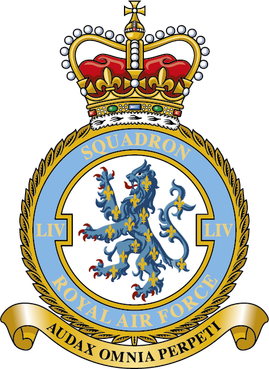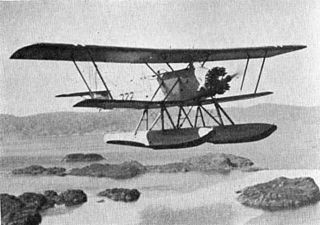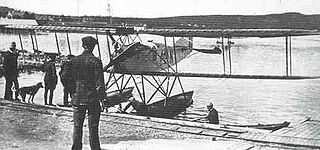Related Research Articles

The Gloster Gladiator is a British biplane fighter. It was used by the Royal Air Force (RAF) and the Fleet Air Arm (FAA) and was exported to a number of other air forces during the late 1930s.

Number 54 Squadron is a squadron of the Royal Air Force based at RAF Waddington, Lincolnshire. On 1 September 2005, it took on the role of Intelligence, Surveillance and Reconnaissance (ISR) Operational Conversion Unit, and is now the Advanced Air ISTAR Academy, responsible for training all RAF crews assigned to the MQ-9A Reaper, Protector RG1 (MQ-9B), Shadow R1/R2, RC-135W Rivet Joint and Poseidon MRA1. It also controls the RAF ISR Warfare School (ISRWS) who run the Qualified Weapons Instructor Intelligence, Surveillance and Reconnaissance and QWI Reaper Courses.

Number 33 Squadron of the Royal Air Force operates the Airbus Helicopters Puma HC.2 from RAF Benson, Oxfordshire.

The Royal Norwegian Navy Air Service was alongside the Norwegian Army Air Service the forerunner to the modern-day Royal Norwegian Air Force.

Royal Air Force Nicosia or more simply RAF Nicosia is a former Royal Air Force station on the island of Cyprus, built in the 1930s. The station served as Headquarters Royal Air Force Cyprus from 8 June to 29 July 1941.

Royal Air Force Horsham St Faith or more simply RAF Horsham St Faith is a former Royal Air Force station near Norwich, Norfolk, England which was operational from 1939 to 1963. It was then developed as Norwich International Airport.

The Marinens Flyvebaatfabrikk M.F.11 was a three-seat, single-engine biplane used by the Royal Norwegian Navy Air Service for maritime reconnaissance in the decade before the Second World War.

The Marinens Flyvebaatfabrikk M.F.12 was a seaplane built in Norway in 1939 as a military trainer aircraft to replace the Norwegian Navy's aging fleet of M.F.8 trainers. Only a single prototype was constructed before Germany's invasion of Norway in 1940. The prototype, M.F.12 F.14 (V), was the last trainer built for the Royal Norwegian Navy Air Service (RNNAS).

The Marinens Flyvebaatfabrikk MF.8 was a military training seaplane built in Norway in the 1920s.
The Marinens Flyvebaatfabrikk M.F.4 was a biplane floatplane built by the Royal Norwegian Navy Air Service aircraft factory Marinens Flyvebaatfabrikk from 1918. The aircraft was the first purpose-built trainer aircraft in Norwegian service and served until retired in October 1924.
The Marinens Flyvebaatfabrikk M.F.7 was a two-seat biplane floatplane built by the Royal Norwegian Navy Air Service aircraft factory Marinens Flyvebaatfabrikk in 1923. The M.F.7 was designed and employed as a trainer aircraft, and functioned as a temporary solution until a better aircraft was designed. Soon after it entered service, the aircraft factory's experience with the M.F.7 led to the construction of the Marinens Flyvebaatfabrikk M.F.8, which remained in service as the main trainer aircraft of the Royal Norwegian Navy Air Service until the German invasion of Norway in 1940.
The Marinens Flyvebaatfabrikk M.F.6 was a two-seat biplane floatplane built by the Royal Norwegian Navy Air Service aircraft factory Marinens Flyvebaatfabrikk in 1921. The M.F.6 was designed and employed as a trainer aircraft. The type was the last pusher configuration aircraft in service with the Royal Norwegian Navy Air Service. The M.F.6 functioned as a makeshift solution until a more modern tractor configuration aircraft could be built. The type was retired once a more permanent solution to the Royal Norwegian Navy Air Service's training needs was found in mid-1920s.

759 Naval Air Squadron was a Naval Air Squadron of the Royal Navy's Fleet Air Arm. It was created on November 1, 1939, and was disbanded on December 24, 1969. It was initially intended as a Telegraphist Air Gunner Training Squadron but became a Fighter School and Pool Squadron in 1939, at RNAS Eastleigh. It operated out of RNAS Yeovilton from 1940 to 1946, as part of the Naval Air Fighter School. In 1943 a detachment operated out of RNAS Angle, working with 794 NAS and known as the Naval Air Firing Unit. It was again the Naval Air Fighter School upon reformation in 1951 and disbandment in 1954, firstly at RNAS Culdrose and then moving to RNAS Lossiemouth, in 1953. The squadron reformed again, this time at RNAS Brawdy in 1963, as the Naval Advanced Flying Training School, before finally disbanding in 1969.

770 Naval Air Squadron was a Naval Air Squadron of the Royal Navy's Fleet Air Arm. It last disbanded at HMS Nighthawk, RNAS Drem in October 1945. 770 Naval Air Squadron initially formed as a Deck Landing Training Squadron at HMS Daedalus, RNAS Lee-on-Solent, in November 1939. Embarked in HMS Argus, and operated from the aircraft carrier and Hyeres la Palyvestre in the south of France, until it disbanded in May 1940. It reformed at HMS Merlin, RNAS Donibristle, on New Year’s Day 1941, as a Fleet Requirements Unit out of 771 Naval Air Squadron’s 'X' Flight. It moved to HMS Jackdaw, RNAS Crail, in June 1941, then two and half years later it moved to HMS Jackdaw II, RNAS Dunino in January 1944, before finally moving to HMS Nighthawk in July.

775 Naval Air Squadron was a Naval Air Squadron of the Royal Navy's Fleet Air Arm which last disbanded in March 1946. 775 Naval Air Squadron formed at HMS Grebe, RNAS Dekheila, during November 1940, as a Fleet Requirements Unit in support of the Mediterranean Fleet, based at Alexandria, Egypt. Between October 1941 and March 1942 the squadron also included the RN Fighter Flight. It absorbed 728 Naval Air Squadron in July 1943 and moved to R.N.Air Section Gibraltar at the start of February 1944. The squadron returned to HMS Grebe, RNAS Dekheila during August 1945.
References
- ↑ "The Gloster Gladiator in the Norwegian Army Air Service (Haerens Flygevåpen)". surfcity.kund.dalnet.se. Retrieved 2021-03-12.
- ↑ Persyn, Stenman and Thomas. 2009. p. 50.
- ↑ "Fokker CVD". The National Norwegian Aviation Museum. Retrieved 2021-03-13.
- ↑ JDG (2010-03-14). "Caproni Ca.310 Overview and Specifications". Comando Supremo. Retrieved 2021-03-14.
- ↑ "Displaying Aircraft Type - Aviation Fanatic". aviationfanatic.com. Retrieved 2021-03-14.
- ↑ "BREDA BA.28 - 1936 -1940 / Flyene i Marinens flygevåpen / MARINENS FLYVEVÅPEN (1912-1944) / Sjøforsvaret - organisasjon, avdelinger og drift 1814-2016 / Marinemuseet / Forsvarets museer - Website Interface". forsvaretsmuseer.no. Retrieved 2021-03-14.
- ↑ asisbiz.com (2020-11-01). "Arado Ar 196A-3 Stammkennzeichen Stkz CK+EQ Norway 1941". asisbiz. Retrieved 2021-03-14.
- ↑ "De Havilland Cirrus Moth". BAE Systems | United Kingdom. Retrieved 2021-03-14.
- ↑ "De Havilland DH-82A Tiger Moth". The National Norwegian Aviation Museum. Retrieved 2021-03-14.
- ↑ "Displaying Aircraft Type - Aviation Fanatic". aviationfanatic.com. Retrieved 2021-03-14.